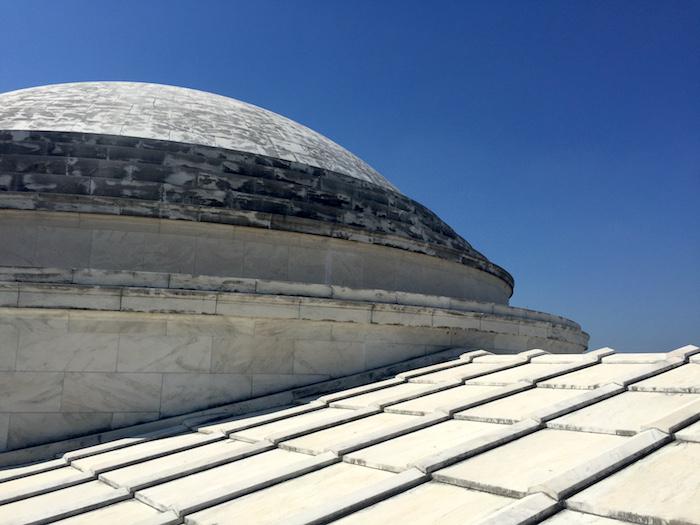
Tests have demonstrated that a laser treatment can remove a "biofilm" that has darkened the top of the Jefferson Memorial on the National Mall/Trust for the National Mall
National Park Service staff were satisfied with a test using a laser treatment to remove a "biofilm" that has darkened the dome of the Thomas Jefferson Memorial on the National Mall in Washington, D.C.. The test paves the way to ultimately clean the rest of the memorial.
“We’re very satisfied with the results of this laser ablation test,” said Architectural Conservator Justine Bello. “The level of clean that was achieved exceeded our expectations. We were able to clean the stone in a safe manner that protected both this cultural resource and the surrounding natural environment as well.”
Conducted over the last four weeks, the test treatment cleaned 1,000 square feet of the 10,682 square feet that comprise the dome of the Jefferson Memorial. The results will be visible as the scaffolding is removed from the Jefferson Memorial dome over the next week, a Park Service release said.
The National Park Service tentatively plans to remove the rest of the biofilm concurrently with a project to rehabilitate the Jefferson Memorial roofs in 2018. That project is included in the requested FY18 budget for the National Park Service.
The blackening effect of biofilm, a colony of microscopic organisms that adheres to stone surfaces, was first noticeable in discrete areas of the memorial’s white marble in 2006, and has become more pronounced in recent years. A multi-disciplinary team of conservators, architects and other professionals has been studying the growth on the Jefferson Memorial since 2014 to determine the best treatment options.
Since announcing the search for a successful cleaning method in August 2016, the National Park Service reviewed hundreds of potential products and processes, considering not only their effectiveness on the biofilm, but also how they might impact the memorial’s historic stone and the surrounding natural environment.
Laser ablation offers maximum protection to both the memorial’s cultural and natural resources: by fine-tuning the laser settings to the specific stone and soiling types, the specially trained laser operators can remove the biofilm without damaging the historic marble of the memorial, according to the Park Service The use of laser is also an environmentally sound procedure and eliminates the need to use more aggressive chemicals or abrasive cleaning methods.
The laser ablation test was conducted by Conservation of Sculpture and Objects Studio, Inc., a Chicago-based conservation firm.

 Support Essential Coverage of Essential Places
Support Essential Coverage of Essential Places







Add comment